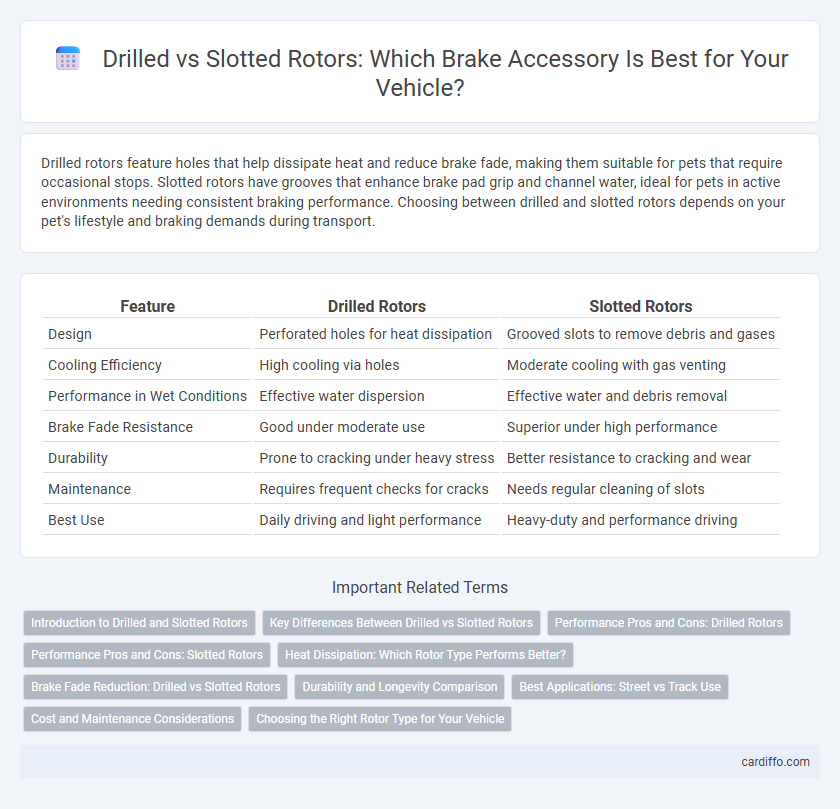Drilled rotors feature holes that help dissipate heat and reduce brake fade, making them suitable for pets that require occasional stops. Slotted rotors have grooves that enhance brake pad grip and channel water, ideal for pets in active environments needing consistent braking performance. Choosing between drilled and slotted rotors depends on your pet's lifestyle and braking demands during transport.
Table of Comparison
| Feature | Drilled Rotors | Slotted Rotors |
|---|---|---|
| Design | Perforated holes for heat dissipation | Grooved slots to remove debris and gases |
| Cooling Efficiency | High cooling via holes | Moderate cooling with gas venting |
| Performance in Wet Conditions | Effective water dispersion | Effective water and debris removal |
| Brake Fade Resistance | Good under moderate use | Superior under high performance |
| Durability | Prone to cracking under heavy stress | Better resistance to cracking and wear |
| Maintenance | Requires frequent checks for cracks | Needs regular cleaning of slots |
| Best Use | Daily driving and light performance | Heavy-duty and performance driving |
Introduction to Drilled and Slotted Rotors
Drilled rotors feature precision-cut holes that improve heat dissipation and reduce brake fade by allowing gases and debris to escape efficiently during braking. Slotted rotors have grooves machined into the surface to enhance pad bite and maintain a clean contact area, improving overall braking performance. Both designs optimize stopping power and durability, catering to different driving conditions and performance needs.
Key Differences Between Drilled vs Slotted Rotors
Drilled rotors feature evenly spaced holes that enhance heat dissipation and reduce brake fade by allowing gases and water to escape, making them ideal for wet or performance driving conditions. Slotted rotors have grooves that maintain pad cleanliness, improve braking performance by preventing pad glazing, and offer consistent braking under heavy loads, especially in aggressive driving. Choosing between drilled and slotted rotors depends on specific driving needs, with drilled rotors excelling in cooling efficiency and slotted rotors providing better durability and braking stability.
Performance Pros and Cons: Drilled Rotors
Drilled rotors offer improved heat dissipation and reduced brake fade due to the holes that allow gases and heat to escape more efficiently during aggressive braking. They provide enhanced wet weather performance by channeling water away from the rotor surface, resulting in more consistent braking. However, drilled rotors tend to be less durable under extreme stress and may develop cracks over time compared to slotted rotors.
Performance Pros and Cons: Slotted Rotors
Slotted rotors improve braking performance by enhancing heat dissipation and preventing gas buildup between the brake pad and rotor surface, which reduces brake fade during intense driving conditions. Their design ensures consistent pad bite and better water and debris removal, contributing to reliable stopping power in both dry and wet environments. However, they can cause increased pad wear and noise compared to drilled rotors, potentially requiring more frequent maintenance.
Heat Dissipation: Which Rotor Type Performs Better?
Drilled rotors offer superior heat dissipation due to multiple holes that allow heat and gases to escape quickly, reducing brake fade during intense driving conditions. Slotted rotors also enhance heat dissipation by providing continuous airflow through their grooves, but their design focuses more on maintaining pad cleanliness and debris removal. For optimal heat management, drilled rotors generally perform better in high-temperature applications, while slotted rotors excel in maintaining consistent braking performance over extended periods.
Brake Fade Reduction: Drilled vs Slotted Rotors
Drilled rotors excel at brake fade reduction by providing superior heat dissipation through their holes, which allow hot gases and water to escape more efficiently during heavy braking. Slotted rotors enhance fade resistance by channeling gas, dust, and water away from the brake pad surface, maintaining consistent friction and preventing glazing. Choosing between drilled and slotted rotors depends on the driving conditions, with drilled rotors favored for wet environments and slotted rotors preferred for aggressive, high-temperature braking scenarios.
Durability and Longevity Comparison
Drilled rotors offer enhanced heat dissipation but tend to develop cracks over time, compromising durability and reducing lifespan under heavy braking conditions. Slotted rotors provide superior longevity by efficiently expelling gases and debris without the risk of cracking, making them ideal for high-performance and frequent use. The choice between drilled and slotted rotors largely depends on balancing heat management with the rotor's resistance to wear and structural fatigue.
Best Applications: Street vs Track Use
Drilled rotors excel in street applications by enhancing heat dissipation and reducing brake fade during everyday driving. Slotted rotors offer superior performance on the track by improving pad bite and expelling gas, dust, and debris for consistent braking under extreme conditions. Choosing the right rotor type depends on whether the primary use is regular street driving or intense track sessions.
Cost and Maintenance Considerations
Drilled rotors typically cost more upfront due to their manufacturing complexity but offer enhanced heat dissipation, reducing brake fade and maintenance frequency. Slotted rotors, while generally more affordable, excel in debris removal and consistent braking performance, potentially lowering long-term maintenance costs by preventing uneven pad wear. Evaluating both options involves balancing initial expenditure against durability and maintenance intervals to optimize overall brake system investment.
Choosing the Right Rotor Type for Your Vehicle
Choosing the right rotor type for your vehicle depends on driving conditions and performance needs; drilled rotors excel in heat dissipation under moderate braking, while slotted rotors offer superior debris removal and consistent braking under heavy use. High-performance vehicles and aggressive drivers benefit from slotted rotors due to enhanced friction and reduced brake fade. For daily commuting or light performance driving, drilled rotors provide effective cooling and stylish appearance without compromising brake longevity.
Drilled Rotors vs Slotted Rotors Infographic

 cardiffo.com
cardiffo.com